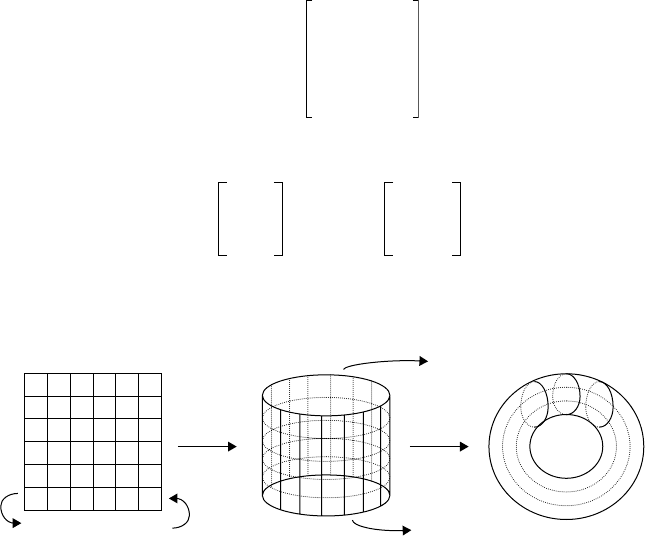Fishwick P.A. (editor) Handbook of Dynamic System Modeling
Подождите немного. Документ загружается.


28-32 Handbook of Dynamic System Modeling
represents. An Energy Systems Language model can become a record of the evolving state-of-the-art
understanding about a given system that can transcend generations of environmental managers. Each
generation can improve the model as the interplay between measured phenomena and model prediction
proceeds.
Flaws in understanding and difficulty in detecting dynamic phenomena each interfere with success-
ful environmental systems management. Environmental data in the absence of an explanation may add
description, but does little for understanding. Simulation models, in the absence of dynamic phenomena
from the real system, are untested hypotheses that produce a prediction of dynamics waiting to be tested.
With continued cycling between model formulation and measurement of phenomena, the high level of
understanding of self-organized environmental systems required to manage such systems will be forth-
coming. It is the interplay between models and measurement of dynamics that can guide understanding
toward management principles that work.
A system model can be built that shows impossible dynamics, sometimes intriguing ones, and perhaps
less often accurate ones. Nevertheless, Energy Systems Language opens the door to a rigorous energy
theory of nature that, perhaps unlike the models themselves, continues to have an enormous practical
impact on the observation, analysis, and management of ecosystems today.
Acknowledgments
This chapter is dedicated to the memory of Professor H.T. Odum with whom the author was privileged to
work and learn as a colleague and friend for over 20 years. This chapter reflects the author’s understanding
of Professor Odum’s methods. Thanks to Dr. Mark T. Brown, also a longtime colleague of Dr. Odum, and
to Elizabeth C. Odum, Dr. Odum’s spouse and frequent coauthor, for reviewing the first draft manuscript
of this chapter. A third in-house reviewer, Mr. Mike Lemmons, provided in-depth review from a novice’s
point of view. Considerable revision resulted from these reviews, the comments of three anonymous
reviewers, and the editor, Paul Fishwick. The author owes a debt of gratitude to each of these reviewers for
a greatly improved, clarified, and more substantive presentation of Energy Systems Language.
References
Coultas, C.L. and Y.-P. Hsieh (eds.), Ecology and Management of Tidal Marshes: A Model from the Gulf of
Mexico. St Lucie Press, Delray Beach, FL, 355pp.
Forrester, J. 1961. Industrial Dynamics. MIT Press, Cambridge, MA.
Forrester, J. 1968. Principles of Systems. Wright-Allen Press, Cambridge, MA.
Montague, C.L. and H.T. Odum. 1997. Introduction: The intertidal marshes of Florida’s Gulf coast. In
Coultas, C.L. and Y.-P. Hsieh (eds.), Ecology and Management of Tidal Marshes: A Model from the
Gulf of Mexico. St Lucie Press, Delray Beach, FL, pp. 1–7, 355pp.
Odum, H.T. 1983. Systems Ecology: An Introduction. Wiley, New York, 644pp.
Odum, H.T. 1994. Ecological and General Systems: An Introduction to Systems Ecology. University Press of
Colorado, Boulder, CO, 644pp. (revised edition of Odum, 1983).
Odum, H.T. 1996. Environmental Accounting: Energy and EnvironmentalDecision Making. Wiley, NewYork,
370pp.
Odum, H.T. and E.C. Odum. 2000. Modeling for All Scales: An Introduction to System Simulation. Academic
Press, London, 458pp.
Odum, H.T. and E.C. Odum. 2001. A Prosperous Way Down. University Press of Colorado, Boulder, CO,
326pp.

29
Ecological Modeling and
Simulation: From
Historical Development
to Individual-Based
Modeling
David R.C. Hill
Blaise Pascal University
P. Coquillard
Université de Nice-Sophia Antipolis
29.1 Introduction ...............................................................29-1
29.2 An Old Story? .............................................................29-2
29.3 Determinism or Probability?......................................29-5
29.4 Modeling Techniques .................................................29-5
29.5 The Use of Models in Ecology ...................................29-6
29.6 Models are Scientific Instruments ............................29-7
29.7 Levels of Organization and Methodological
Choices .......................................................................29-8
29.8 Individual-Based Models ...........................................29-9
29.9 Applications ...............................................................29-12
29.10 Conclusion .................................................................29-15
29.1 Introduction
Ecology studies the relationships between living organisms (individuals)—vegetal or animal—and the
environment in which they live. The biosphere in which we live is made up of the whole set of terrestrial,
marine, and aerial ecosystems. A scientist who endeavors to explain the relationships and the interactions
within an ecosystem must often be in contact with colleagues more specialized in other fields like chemistry,
genetics, oceanography, geography, hydrology, ethology, and climatic sciences. Considering the complexity
of this multidisciplinary study, modeling is a fundamental tool to understand ecosystems. A good modeling
practice is to design a model with a precise goal in mind; a modeler expects that his model outputs (results)
will help understanding the real system under study. The model final objective also helps selecting the
model simplifying assumptions and the level of realism, taking into account the limits of our knowledge
and the limits of our modeling techniques. Even if we had precise descriptions and observations, estimating
future trends will always be considered very risky. Considering the lack of biological data, we see in Begon
et al. (1990) that many ecologists focus on the following levels of organization: individuals, populations
of individuals, and ecosystems.
In this chapter, we will first focus on the history of ecological modeling, starting in the twelfth century. A
discussion will present the controversy opposing deterministic and probabilistic approaches in ecological
29-1

29-2 Handbook of Dynamic System Modeling
modeling. We follow this discussion by an overview of the model types employed by ecological modelers.
The main focus is then given to individual-based models (IBMs). They appeared in the seventies (Kaiser,
1976, 1979; Lomnicki, 1978) and have been more intensively used since the remarkable paper from
Huston et al. (1988). Individual-based modeling is a bottom-up approach focusing on the individuals
(i.e., the parts) of an ecological population (i.e., the system). Then, the modeler tries to understand how
the properties of the population can emerge from the interaction among individuals. The strengths and
weakness of IBMs will be presented. Despite their advantages, bottom-up approaches are not sufficient
to build theories at the population level (Grimm, 1999). Indeed, more traditional mathematical models,
with state variables, described “top-down” and used like black boxes, provide integrated views replying to
relevant questions at the population level.
29.2 An Old Story?
The great adventure of modeling ecological processes began at the end of the twelfth century with regard
to a story about rabbits, in Pisa, Italy. In this thriving commercial town, young Leonardo of Pisa (1175–
1240) is very rapidly confronted with practical problems of arithmetic. Leornardo, son of Guilielmo and
a member of the Bonacci family, is trying to solve what appears at first sight to be quite a simple problem:
a couple of young rabbits will become adult and then will produce at each mating season, a new couple of
young rabbits. After a new season, the new couple has grown up and is in turn able to produce another
couple of rabbits. The question is how many rabbits will there be after “n” seasons?
In Table 29.1, it can be seen that the number of adult couples at season n is equal to the total number of
couples at season n −1, and that the number of young couples at season n is equal to the total number of
couples at season n −2. A little reflection convinces us very quickly that the total number of rabbit couples
at season n can be computed with the following sequence:
T
n
= T
n−1
+T
n−2
(29.1)
This formula generates a series of numbers whose characteristic is that each number is equal to the sum
of the two previous numbers. Generally, this sequence is known as Fibonacci numbers: 1, 1, 2, 3, 5, 8,
13, 21, 34, 55, 89, 144, 233, 377, 610... The Fibonacci name was given in the nineteenth century by
Guillaume Libri, a mathematics historian (Leonardo of Pisa, was son of Bonacci: Filius Bonacci—which
gave the Fibonacci nickname). Naturally, the Fibonacci sequence is not very realistic for this problem, since
for instance it takes no account of mortality and running out of food resources. However, this sequence
has numerous other interesting applications for basic ecological models. Indeed, Fibonacci numbers
are interesting in understanding honeybees family trees, petals on flowers, seed heads, pinecones, leaf
arrangements, and even shell spirals. All the previously cited natural elements use what mathematicians
call the golden ratio. Curiously, we can perceive that the ratio T
n
/T
n−1
is converging to a particular value,
21/13 1.615; 34/21 1.619; 144/89 1.617; 610/377 1.618. This value is called the golden ratio or the
TABLE 29.1 Number of Couples at Season n
Season Total Number of Couples Number of Adult Couples Number of Young Couples
n (= T
n
)(= T
n−1
)(= T
n−2
)
11 0 1
21 1 0
32 1 1
43 2 1
55 3 2
68 5 3
713 8 5
8 ... ... ...

Ecological Modeling and Simulation 29-3
golden number (∼1.618034 and often represented by a Greek letter Phi [φ]) and it has also been used by
humans in many artistic creations, including architecture.
Thereafter, several centuries go by before mathematicians take an interest in biological and ecological
problems: Bernouilli in the eighteenth century proposes a mathematical theory of smallpox epidemic;
then, in the nineteenth, Malthus and Quetelet take an interest in the dynamics of human populations. But
it is Pierre François Verhulst (Verhulst, 1845), a Belgian mathematician, who invents in 1844 the famous
S curve known as the logistic curve:
dy
dt
= ry
K − y
K
(29.2)
This is the foundation of mathematical modeling applied to biological sciences, strongly influencing the
modeling of system dynamics throughout the twentieth century. This equation has been studied in depth,
notably in its discrete form. It will also be integrated in the famous double equation system, attributed
independently to Lokta (1925) and Volterra (1926), where they propose a mathematical formalism for the
relationship between consumers and resources.
Finally, mathematical modeling of sciences, apart from the strict circle of Physics, does not take off
until the twentieth century. In the nineteenth century, biological sciences were not particularly favorable
to using mathematical formalism. According to Giorgio Israel this can be explained by“The old ambition,
still alive and kicking, to achieve a unified mechanical and reductionistic description of the world, an
ambition resisting all difficulties and all failures.”Again, according to the same author: “The fundamental
method of modeling in the 20th, is mathematical analogy (where the fragment of mathematics unifies all
the phenomena it is supposed to represent), and no longer mechanical analogy, which has been for a very
long time, the principal mathematical method.”
With a mathematical analogy, Leslie (1945) presentedto an adaptation of MarkovChainsto the dynamics
of populations. This technique is interesting for modeling the changes in age-structured populations
(Figure 29.1).
In 1965, Lefkovitch introduced an alternative approach. A similar matrix model considers population
growth in organisms grouped by stages instead of age (Lefkovitch, 1965) (stage-specific survival rates).
Kent Holsinger gives the following reasons to explain why Lefkovitch models are often preferred to Leslie
matrix:
•
It’s often difficult or impossible to age animals and plants accurately.
•
In some organisms, especially perennial plants, survivorship and fecundity are more related to size
(or some other variable by which a population might be stage-classified) than to age.
•
In some organisms, especially herbaceous perennial plants, individuals may actually revisit stages
they already left, e.g., they may get smaller from one season to the next.
•
Focusing on life-cycle stages helps to focus attention on identifying the critical transitions that may
provide opportunities for management. (Holsinger, 2005)
At the end of the eighties, Caswell (1989) also adapted Leslie’s matrix to model the development of a species
of a vegetal species (Dipsacus sylvestris) in six development stages (from seed to flowering plant). Finally,
P ⫽
0
0
p
1
F
1
...
0
0
p
2
F
2
...
0
0
p
n⫺1
F
n⫺1
...
0
0
0
F
n
...
...
...
......
...
FIGURE 29.1 A Leslie matrix. The first row contains the fertilities (F
i
)ofeachthen class of age. p
i
represents the
transition probability (i.e., the survival probability) from one class of age to the next.

29-4 Handbook of Dynamic System Modeling
M
AS
(p) ⫽
TT
T
T
FFFF
...00
(a)
...............
00...0
00...0
...
Where the submatrices F (fertilities) and T (transition) are for instance:
and
000
000
f
3
f
2
f
1
F ⫽
0
0
00
q
3
q
2
p
2
q
1
p
1
T ⫽
(b)
FIGURE 29.2 (a) A stage-by-age model or multistate model. (b) Fertilities and transition matrix.
Folding of the
dimensions
To obtain a torus:
pseudo-infinite 2D grid
Finite 2D grid
FIGURE 29.3 Folding of a finite 2D grid to obtain a pseudo-infinite grid.
Lebreton (2005) proposed a stage-by-age models (or a multistate model) uniting the two characteristics
state and time (Figure 29.2[a] and Figure 29.2[b]).
After the Second World War, the original thoughts on self-reproducing cellular automata were intro-
duced. “This introduction can be traced back to 1948 when John von Neumann gave a talk entitled “The
General and Logical Theory of Automata” (Von Neumann, 1951). More than a decade later, Von Neu-
man, Ulam, and John Conway introduced self-reproducing cellular automata (Von Neumann, 1966; Burks,
1970) and the Game of Life (Gardner, 1970). Von Neumann and Ulam were modeling a minimal biological
self-reproduction and the Conway mathematical game was introduced to a wide public thanks to columns
written by Martin Gardner in Scientific American. The result was a famous synchronous spatial model,
centered on cells, and with a time-based evolution. The future of a cell depends on rules relying on the
other cells in its neighborhood. Each cell on a pseudo-infinite 2D grid (obtained by folding, Figure 29.3)
has two potential states: dead or alive. The generated cells are clones, exactly the same as the parent. From
these basic elements, more complex models can take into account heredity, variability, fitness and other
characteristics, which can be useful to model for instance the evolution by means of natural selection. Here
are the basic transition rules applied at each time step in the first issue of the Game of Life:
•
If two or three neighbors of a cell are alive and the cell itself is currently alive, its next state is alive.
•
If three neighbors of a cell are alive and the cell itself is currently not alive, its next state is alive.
•
Otherwise the next cell state is dead.
Those simple rules weresufficient to give risetoorder from an apparent“chaos.”Scientists rapidly identified
patterns like blinkers, gliders, guns, which grow and evolve for very long periods. Some other patterns
lead to dying or stagnating configurations. Since the theory of cellular automata was introduced, many
enhancements were proposed and the theory was simplified in the 1980s by Langton and Byl (Wolfram,

Ecological Modeling and Simulation 29-5
1986). Cellular automata have also been recently embedded in the powerful Cell-DEVS environment,
which has been successfully applied to different ecological models (Wainer and Giambiasi, 2001). We
would not stay too long on cellular automata since they are detailed in a specific chapter of this book,
proposed by Peter Sloot.
29.3 Determinism or Probability?
Evidently, from what has just been said, the mathematical approach, i.e., deterministic, represents the base
on which modeling and simulation in environmental sciences has been developed. The introduction of
randomness with Monte Carlo simulation and the question of using models with probabilistic components
provoke fierce scientific controversy. For example, Papoulis explains: “The controversy of determinism
and causality versus randomness and probability has been the topic of extensive discussions […] the
phenomenon is thus inherently deterministic, and probabilistic considerations are necessary only because
of our ignorance” (Papoulis, 1965). Up to the early seventies, the majority of models concerning ecology
are deterministic. The position of Norman E. Kowal (1971, pp. 123–171) sums up the aversion of scientists
at that time to use probabilistic processes. Concerning ecological processes, which present: “Changes in
Space, or in Space and Time,” he writes:“Since there is more than one independent variable (two or three for
space, and, perhaps, one for time), the required mathematical theory becomes very complex and difficult
to work analytically. The most useful mathematical structures to use as models of such systems are partial
differential equations […] these models will probably always be solved by numerical approximation on
digital computers.” In the last sentence of his paragraph he also states that: “Probability density functions
may also be used.” In the Coda Volume I of System Analysis and Simulation in Ecology, Bernard C. Patten
writes: “Simulation models do not have to reproduce dynamic behavior realistically to be useful […] the
thought that goes into them may be their greatest value” (Patten, 1971). Patten preferred to reduce the
realism of the model rather than include stochastic aspects. From our point of view, the final modeling
goal has to be borne in mind when deciding whether or not a modeler can abandon the reproduction of
realistic behavior.
Thanks to the steady increase in memory capacity and calculation speed, to the emergence of procedural
and object-oriented programming languages, the limits of ecosystem modeling have rapidly extended.
Dealing with spatial systems and processes dependant on time, scientists found themselves confronted
with such a complexity that deterministic mathematics alone could not resolve (Jorgensen, 1994).
29.4 Modeling Techniques
Whether deterministic or not, there is a plethora of modeling techniques. Using the “Science direct”
database from Elsevier, we have built a classification of the most employed techniques found in papers
published in the Ecological Modeling journal since 1975 (Table 29.2). Most of them are not specific to
ecological modeling and they are detailed in other chapters of this book.
Two expressions in Table 29.2 do not belong to usual simulation vocabulary: Individual Based Model
and Gap Model. It is an example of vocabulary introduced by ecologists to qualify some kinds of simulation
models. IBMs have already been introduced, so we will present the Gap models. They are dedicated to the
simulation of vast forest spaces, discretized into small units (a few m
2
) on which the number of trees of
different categories and species, the transition probabilities and the reproduction success probabilities are
known. The term Gap model comes from the fact that these models were developed originally to simulate
the behavior of a forest area in which, over the course of time, a natural process of clearings healed up
more or less rapidly depending on characteristics of their immediate environment.
If we analyze more deeply the published databases in ecological modeling, we can see that ecological
specialists have now been using discrete simulation and IBMs more intensively particularly over the last
two decades (Grimm et al., 1999). Multiagent models can be considered as a special case of IBMs where

29-6 Handbook of Dynamic System Modeling
TABLE 29.2 Results Extracted using the Science Direct Database on the Ecological
Modeling Journal (between 1975 and 2005). Expressions were Researched in the Titles,
Keywords, and Abstracts. In Brackets the Results Obtained by Extending the Search to
Journals Filed in Environmental Sciences
Expression Number of Articles
Model OR Modeling 3576 (36308)
Simulation 1361 (8146)
Mathematical model 298 (9396)
Individual-based model 106
Neural network 104 (1801)
Markov OR Leslie 91 (2273)
Cellular automata 46 (441)
Bayesian statistics 42 (120)
Mixed model 25 (561)
Gap model 26
Multiagent 6 (28)
Multimodel(ing) 4 (96)
individuals have shown a social behavior. This modeling technique is not specific to ecological modeling,
it has been introduced in Artificial Intelligence and more precisely in Distributed Artificial Intelligence.
AdelindeUhrmacher is devoting a chapter of this book to agent-oriented modeling. In ecological modeling,
this approach is particularly interesting for of ethological systems. We have for instance studied herbivorous
animals, and also the memory of ewes at pasture using this approach (Dumont and Hill, 2001, 2004).
This development of individual-based modeling and its derivative can be explained first by the avail-
ability of powerful desktop computers, of user friendly software development environments, and of
prototyping design methods. With such tools and techniques, ecological modelers can study the complex-
ity of many systems they are interested in, in terms of number of animals, plants (or trees), strips of land,
volumes of air, flow of energy, interacting in time and in three dimensions.
This quick review of techniques in ecological models shows that a long road is ahead to use multiagents,
coupled models, mixed models and multimodels with different formalisms. The formalization of models,
using DEVS (Zeigler et al., 2000) or other more formal specification techniques, is still extremely rare
in ecological modeling. In our opinion, their use can be very promising, the introduction of Cell-DEVS
mentioned above, and other recent applications demonstrate the interest of the simulation community in
applying such advances to ecological and environmental models (Muzy et al., 2005).
29.5 The Use of Models in Ecology
In ecological modeling, the knowledge acquired these last decades experienced a spectacular growth
correlatively with the mastering of new sampling techniques (satellite and space imagery; radiogoniometric
follow-up of animals; automation of the physicochemical data acquisition of air and water), of numerical
analysis techniques (statistical analysis of multidimensional data and analysis of time series), and of data-
processing tool (hardware and software). At the same time, this amount of data made decision makers
aware of a wiser management of human activities. Table 29.3 presents several ecological topics discussed
in the Ecological Modeling Journal (still between 1975 and 2005).
In Table 29.3, we notice that the predominant subject of interest is incontestably the problem of
biodiversity, followed, but at a considerable distance, by global change, forestry problems, and population
dynamics. We therefore find here subjects covered by the media in the news, even though fundamental
research subjects are not neglected, as is proved by the 334 articles on population dynamics or the prey–
predator relationship. The greenhouse effect is almost not covered by the Ecological Modeling journal.
This can also be noticed in the “Environmental Sciences” section where only 197 references are found on
this subject, which, in reality, is dealt with by climatology specialists in collaboration with ecologists.

Ecological Modeling and Simulation 29-7
TABLE 29.3 Number of Articles found in the Ecological Modeling
Review (1975–2005) Related to Several Ecological Topics
Expression Number of Articles
Organic matter 100
Nitrogen OR nitrogen cycle 295
Carbon OR carbon cycle 290
Global change 344
Greenhouse effect 2
Fish model 122
Fishing model 83
Trees OR forest 636
Populations dynamics 344
Predator–Prey 97
Productivity 187
Behavioral model 192
Biodiversity 2947
Plant architecture 34
TABLE 29.4 Number of Articles found in the Ecological
Modeling Review (1975–2005) Related to Ecosystems
Expression Number of Articles
Taïga 44
Tundra 145
Temperate forest 130
Tropical forest 198
Meadows 206
Arid ecosystem 18
Lake 141
River 227
Desert 275
Marine ecosystem 187
Estuarine ecosystem 29
Coral reef 10
Alga(e) 39
From Table 29.4, we observe that the ecosystems mostly studied by ecologists are mainly terrestrial
ecosystems, notably forest, tropical or not, where an attempt is made to predict their evolution in terms of
production, population structure, and biodiversity for future decades with a supposed changing climate.
Lakes and rivers are also the subject of numerous studies. One could advance the hypothesis that the
management of fresh and drinkable water resources arises today as one of the major challenges over the
next decades. Again from Table 29.4 we note that marine ecosystems are less studied, in spite of their
extremely dominant situation on the globe, and their capital importance in regulating climate. We have
developed models in oceanography and we could explain this small number of studies by the fact that
oceanographic model parameters are difficult to measure, involving costly and occasionally dangerous
operations (Hill et al, 1998; Coquillard et al., 2000).
29.6 Models are Scientific Instruments
From our simulation experience in various application fields, Ecological models basically do not differ—
not even by their complexity—frommodels developed in other disciplines such as meteorology and nuclear
physics, or from the models developed for manufacturing systems.

29-8 Handbook of Dynamic System Modeling
The incredible complexity of the operation of an ecosystem cannot be seized by the simple acquisition
of the whole set of parameters that characterizes it, as this has been the case for a long time when ecology
was confined within a descriptive approach. The latter was a necessary stage, but the multiple interactions
and feedbacks within ecosystems reveal behaviors which one could not seize by the interpretation of data
collected (were they exhaustive). Even if we do not know all the ecosystem parts, studies in complexity
showed that the behavior of a complex system is not equivalent to the sum of the behaviors of the parts
(this is known as the “system effect”). Only a software, modeling the interaction of the various parts of a
system, can reveal the emerging behaviors. Even if models could also show impossible behaviors that only
field experts will be able to detect, they are more and more used for a better comprehension of ecosystems.
In his state-of-the-art textbook, Jorgensen (1994) summarizes in four points the advantages of modeling:
1. Models have their utility in the monitoring of complex systems.
2. Models can be used to reveal the properties of ecological systems.
3. Models can show deficiencies in our knowledge and can be used to define priorities in research.
4. Models are useful to test scientific assumptions, insofar as the model can simulate the reactions of
the ecosystem, which can be compared with the observations.
29.7 Levels of Organization and Methodological Choices
In practice, the development of a model is based on the two following constraints:
1. The objectives to be reached (which types of results are we expecting?).
2. The state of our knowledge concerning the studied system and the data at our disposal (or at least what
it is reasonable to hope to acquire in an assigned time).
These two constraints will define the level of organization (or the scale of the study). The choice of this
scale is in direct relationship with the complexity of the model. Will we be interested in the individuals,
in parts of individuals, in sets of individuals, in whole populations even in sets of populations? It is also
necessary to have in mind that the level of organization will also influence the choice of the modeling
technique that will be implemented. For instance, if we organize our model around the population level,
an individual-based modeling is completely unnecessary. In addition, there must be a close consistency
between the objectives (first point) and the available data (second point). If we only have data at the
molecular level, will it be really consistent to expect results at the population level? The identification of
the level of organization imposes a thorough examination of the data: the objectives being fixed and thus
the working scale determined, it is still necessary to have available data relating to this level of organization.
It is a frequent case that for a given level it is advisable to obtain data concerning a lower scale. Even if the
level of a population is retained, it could be necessary to collect data relating to the individuals. Indeed, the
behavior of the population results from the individual interactions. Biological individuals themselves are
not free from influences coming from the higher levels of the organization hierarchy: other populations,
environmental factors. How many factors do we have to take into account? Which one among them can
be regarded as negligible? There is no absolute rule in this field; a wise approach would be to bear in mind
the main goal of the modeling (i.e., the principal expected results). This will help to simplify the making
of choices.
The level of organization being selected according to the objectives (Figure 29.4), it is appropriate
to specify what is the level of detail. Thus, for a model of forest growth (with a level of organization
corresponding to a population), will we have to take into account, or not, the following nonexhaustive set
of parameters?
•
Seasonal variation of the light intensity.
•
CO
2
partial pressure of the atmosphere.
•
Competition for water resources and ground nutrients.
•
Competition for space.

Ecological Modeling and Simulation 29-9
Biocenosis
Biotope
ECOSYSTEM
Organization
level (scale)
Cell
Organ
Individual
Group
Population
Molecular level
FIGURE 29.4 Organization levels.
•
Density of the settlement.
•
Competition for light.
•
Competition with the shrubby and herbaceous species.
One quickly sees that objectives and data will interact; the choices will be in accordance with the exper-
imental framework. Thus, if we want to model the growth of a local forest over the next 5 years, it is
certainly not necessary to take into account the possible infinitesimal variations of the CO
2
on this interval
of time. In the same way, the seasonal variation of the light intensity received by the settlement does
not appear crucial in the modeling, the whole settlement being subjected to the same light conditions.
Lastly, the competition for resources with the shrubby/herbaceous species will have to be neglected if we
consider that trees escape from this competition. We can also suppose that the forest ecosystem is relatively
homogeneous from this point of view.
A systematic increase in the model complexity by addition of variables will often not make a substantial
improvement in terms of model validation. Beyond a certain point, the addition of new variables does
nothing but increase the complexity of the model and accumulate uncertainties. It even occurs that
these increases in uncertainty make the model radically diverge from the real system under study. It is
often advisable to prefer holistic variables to several elementary variables whose uncertainties can only
obliterate the quality of the model. It goes without saying that an increase in model complexity will add
to the implementation difficulties, the ability to check the internal consistency of the software is reduced,
and computing speed problems can also occur even with our fastest computers. Unless we have specific
goals requiring the implementation of many details, simplification is a virtue in modeling.
Now that we have presented some methodological elements, we will give our main focus to IBMs.
We have seen in the previous sections that many modeling techniques used in ecological modeling are
common to other research fields, most of them are presented in this textbook and our preference goes to
individual-based modeling. This choice is not a way to champion this technique among others and we will
also discuss its drawbacks. However, this technique has met with an interesting development linked to the
evolution of computer technologies. In the next sections we will not distinguish IBMs from individually
oriented models (IOM), though the latter can be more powerful, see Fishwick et al. (1998).
29.8 Individual-Based Models
The IBM approach completes the set of mathematical methods that are still interesting for many appli-
cations (Grimm, 1994; Sultangazin, 2004). For instance, differential equations or partial differential
equations are very efficient to give a rough estimation of the spatial evolution of large areas. However,
